Religious Scraps
Hate Counter
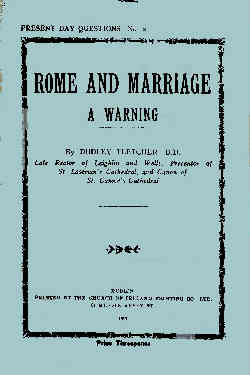 I think it was in the sixties that Michael Viney wrote a series of articles on religion for the Irish Times, one of which dealt with the "Hate Counter" located in the depths of Hodges Figgis Bookshop in Dawson Street, Dublin.
I think it was in the sixties that Michael Viney wrote a series of articles on religion for the Irish Times, one of which dealt with the "Hate Counter" located in the depths of Hodges Figgis Bookshop in Dawson Street, Dublin.Essentially, this counter displayed anti-Roman-Catholic literature. Having read the article I scurried down to the shop and bought some pamphlets. The one illustrated here was among them. It was published in 1951 and warned Protestants not to marry Catholics as their children would ultimately be alienated from them by the Catholic Church. I must say that this assertion did not seem in any way unreasonable or hateful to me as the Catholic Church in Ireland, following the Synod of Thurles in 1850, required the children of mixed marriages to be brought up as Catholics. This dates from the era when "error had no rights" and there was "no salvation outside the Church".
The Second Vatican Council subsequently held out the promise of alleviating this iniquitous situation but it looks as though things may be drifting backward and the pamphlet may bear rereading in the future.
<< Pamphlet in the series Present Day Questions entitled Rome and Marriage - A Warning written by Dudley Fletcher, BD, Late Rector of Leighlin and Wells, Precentor of St. Laserian's Cathedral, and Canon of St. Canice's Cathedral. Printed by the Church of Ireland Printing Company Limited and published in 1951, price threepence. Read the full pamphlet.
Rocky Road
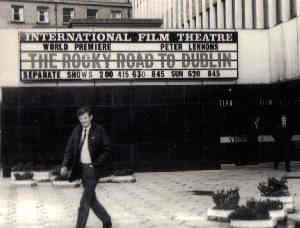 In 1967 Peter Lennon, then a junior correspondent with the Guardian newspaper, made a film called "The Rocky Road to Dublin", as he says, to reveal what had gone wrong with the "new" Republic. He recaps his adventures in detail in a recent article.
In 1967 Peter Lennon, then a junior correspondent with the Guardian newspaper, made a film called "The Rocky Road to Dublin", as he says, to reveal what had gone wrong with the "new" Republic. He recaps his adventures in detail in a recent article. Tom Ferris and I were introduced to Peter through Alec Reid who was a neighbour of ours in Ballybrack. We roped in a few fellow students and gave Peter our considered opinion on the society in which we lived. One of those we had recruited subsequently regretted having been so outspoken and feared it might harm her career prospects so I was elected to tell Peter he could not use the material. Recollection beyond this simple fact is now hazy and I have no idea whether any of our material ever made it to the film.
The photo advertises the world premiere of the film in 1967/8 at the Film Centre in Earlsfort Terrace. I don't know whether this was the initial restricted showing to the 18 people or a subsequent brief run.
Update: since writing the above, the film has now re-emerged. It is available on CD and was screened by RTE recently. It is well worth a look. The style of the time is well caught in the images and the reportage has a war correspondent quality. What struck me most was how what now seems mundane and dated could have created such a furore. But that is the point. It was cutting edge for its day and its unpalatable truths were bluntly expressed.
As far as film stardom goes, our material clearly ended up on the cutting room floor and Peter either substituted, or retained, material from the rival university - Cian Ó hÉigeartaigh & friends from TCD.
Proselytizing
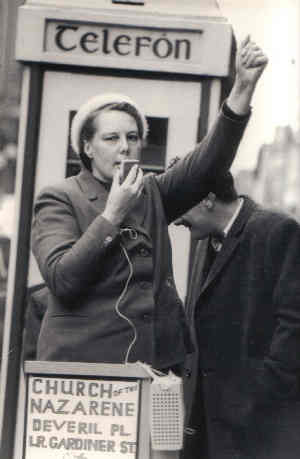 This lady was proselytising on the corner of Abbey St. and O'Connell St. in Dublin in the 1960s. This sort of thing was not uncommon then but was not taken very seriously by most people.
This lady was proselytising on the corner of Abbey St. and O'Connell St. in Dublin in the 1960s. This sort of thing was not uncommon then but was not taken very seriously by most people. There was a regular group on Killiney beach at weekends throughout the summer. Their theme was aptly summed up in a verse on one of their pamphlets: "life is short / death is sure / sin the cause / and Christ the cure". QED.
I remember another group working the cinema queues in Abbey Street when the Exorcist came out. They were offering post performance remedial counselling and their leaflet would scare the bejaysus out of you.
I don't think these groups met with much success. This was a time when most people were set in their religious beliefs and practice. Vatican II was slow to percolate and public scandals were a thing of the future.
Mediation
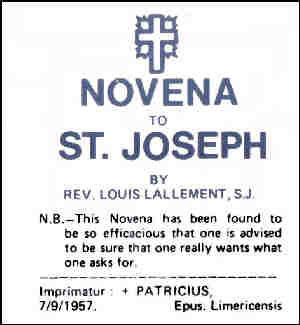 One of the characteristics of the Roman Catholic Church, in comparison, say, with the Protestant Churches, is mediation. The priest in the confessional mediates God's forgiveness and the saints in heaven are frequently called on to mediate contact between the faithful and their creator. Mary, for example, as well as being the Mother of God, also rejoices in the title "Mediatrix of All Graces".
One of the characteristics of the Roman Catholic Church, in comparison, say, with the Protestant Churches, is mediation. The priest in the confessional mediates God's forgiveness and the saints in heaven are frequently called on to mediate contact between the faithful and their creator. Mary, for example, as well as being the Mother of God, also rejoices in the title "Mediatrix of All Graces". Saints were prayed to for favours and everyone had their favourite saint. One of the most popular was Saint Anthony, whose divine mission was to find lost objects. Petitioners ended up pledging increasing amounts of money to the cause of this Divine Venture Capitalist until either the object was found or funding dried up. Amounts pledged in these campaigns were deposited in the various donation boxes which proliferated in churches and beside the cash registers in most local shops. The money usually went to the religious orders associated with the saint concerned and were used to finance the orders' good works.
Money apart, the extreme form of pleading was the Novena. While the word denotes action over nine days, these prayer or self-mortification campaigns varied in length, frequency and intensity. At the end of the day they were a form of spiritual lotto, and those supplicants whose requests were not granted consoled themselves that they had still won the jackpot - the Lord had decided that what they sought would not have been in their interest and they were so much better off without it. I'm not sure if this qualifies for a Catch 22 award or whether there is an appropriate spiritual term to describe this virtuous circle.
Anyway, the leaflet shown here suggests that there are limits to my theories and that the Lord may sometimes doze on the job and accede to requests which are not in the supplicant's real interest. This novena. therefore, wisely, comes with a spiritual health warning vetted by no less than the Bishop of Limerick, of his day. So, beware the power of prayer - you have been warned.
Indulgences
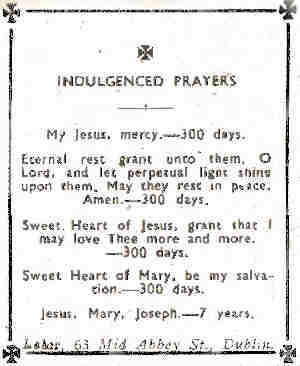 Another instrument of consolation was the indulgence. These could be gained by various "penitential" actions (including prayer and the Mass) and entitled either the supplicant or a nominee to remission of sentence in purgatory (the only time-limited divine detention centre). Indulgences could be plenary, involving complete remission of sentence from the moment of the application of the indulgence, or partial. Partial indulgences were precisely quantified and corresponded to numbers of days remission of sentence. The illustration gives an idea of the going rate for selected ejaculations.
Another instrument of consolation was the indulgence. These could be gained by various "penitential" actions (including prayer and the Mass) and entitled either the supplicant or a nominee to remission of sentence in purgatory (the only time-limited divine detention centre). Indulgences could be plenary, involving complete remission of sentence from the moment of the application of the indulgence, or partial. Partial indulgences were precisely quantified and corresponded to numbers of days remission of sentence. The illustration gives an idea of the going rate for selected ejaculations.
This "price list" often led to a mad scrambling by the faithful to find the maximum return for the minimum effort, or in secular terms the biggest bang for their buck. Compare, for example, the rate of return on the first and last of the examples illustrated.
As an aside, I must say I participated in this scramble in my youth when I was printing memorial cards on an old fashioned Adana printing press, where each letter had to be tweezered into position and the lot locked in place with an allen key.
It was said that Saint Peter's Basilica in Rome was built on the sale of indulgences. Indulgences should not be sold for cash or otherwise. This is a sin called "simony". But the theology is subtle, and there is no bar on "donations" as long as there is no hint of RPM, ie no set minimum amount. For example, a Mass cannot be "bought" but the mass card which is part of the deal could prove quite expensive.
By 1967, shortly after Vatican II, it seems to have dawned on people that the precise quantification of partial indulgences was spurious as there was no indication that any regard was had in purgatory to the orbit or rotation of the earth, or of the moon for that matter. The Vatican tidied up the system which now has only two categories: plenary (full) or partial (unquantified). One assumes that a Divine Task Force was assembled to redeploy those angels formerly employed in the indulgence section of the Great Accounts Branch in the Sky.
Limbo
 Limbo is finally to be abolished after all these years. I bet you thought it had already been abolished in the 1960s? Wrong, it had just dropped out of sight. It really is a very interesting place, not only in relation to its inhabitants, but for what it implies about who was and who wasn't in heaven in the era BC.
Limbo is finally to be abolished after all these years. I bet you thought it had already been abolished in the 1960s? Wrong, it had just dropped out of sight. It really is a very interesting place, not only in relation to its inhabitants, but for what it implies about who was and who wasn't in heaven in the era BC.Limbo was an answer to a problem. It was invented to fill a tricky theological gap that had emerged. But like efforts to plug tax-loopholes, the solution created its own problems and these are only now being formally faced by the Roman Catholic Church authorities. We should wish them Godspeed and lots and lots of luck.
Christ came on earth to redeem mankind and save it from original sin. It follows from this that all those who lived and died before Christ remained in a state of original sin and could not therefore enter Heaven. What to do with these slightly stained souls in waiting ? Why, put them in the ante-chamber. The ante-chamber was called Limbo, meaning the edge or the hem. They were, in a manner of speaking, living on the edge. Post salvation they graduated to Heaven.
The poet Dante lists a number of fellow poets who may have resided there, including Julius Caesar, Cicero and Plato!
There still remained a problem, however. In the Christian era it became necessary to be baptised to enter the Kingdom. No problem for Christians who took to it like water, but what about the other faiths. No problem there either, they should have converted to Christianity. If they didn't, this was by their own choice and they could suffer the consequences: "May you roast in Hell" or as it appeared in the theologically polite version "Outside the Church there is no salvation!".
But what about babies and children who died before reaching the age of reason? They could hardly have made any conscious choice in the matter. This was a cruncher, but nothing a little theo-verbal-wizardry couldn't solve.
This brings us to the invention of a new category of baptism: "baptism of desire". This involves posthumously conferring baptism on those who would have opted for baptism had they known about it, or realised its significance, but did not in fact do so due to ignorance or incapacity. So the "unbaptised" children who were being consigned to Limbo, even up to the 1960s, could now get a free pass into Heaven. The current catechism puts it slightly more obliquely.
 So where does that leave the rest of the unbaptised adult population [Jews, Muslims, Buddists, agnostics etc.]? Are they still roasting away, even in this enlightened age? Today's enlightened view would hold that they really don't deserve Hell, well at least not all of them, and they can't enter Heaven, or can they? Baptism of desire may have redefined some, if not all, of them from Hell direct to Heaven itself, bypassing Limbo entirely. Unfortunately, it is theologically impossible to enumerate the inhabitants of Limbo, from this side, at least. So, is there anyone still there at all, at all, and, if there is, how do we get them out before we close up shop?
So where does that leave the rest of the unbaptised adult population [Jews, Muslims, Buddists, agnostics etc.]? Are they still roasting away, even in this enlightened age? Today's enlightened view would hold that they really don't deserve Hell, well at least not all of them, and they can't enter Heaven, or can they? Baptism of desire may have redefined some, if not all, of them from Hell direct to Heaven itself, bypassing Limbo entirely. Unfortunately, it is theologically impossible to enumerate the inhabitants of Limbo, from this side, at least. So, is there anyone still there at all, at all, and, if there is, how do we get them out before we close up shop?Stay tuned to the current Vatican wind-up exercise and see if the "desire" element of "baptism of desire" engulfs the rest of the human race.
While you're waiting you might be interested in the remarks of a certain bishop at the 2001 synod.